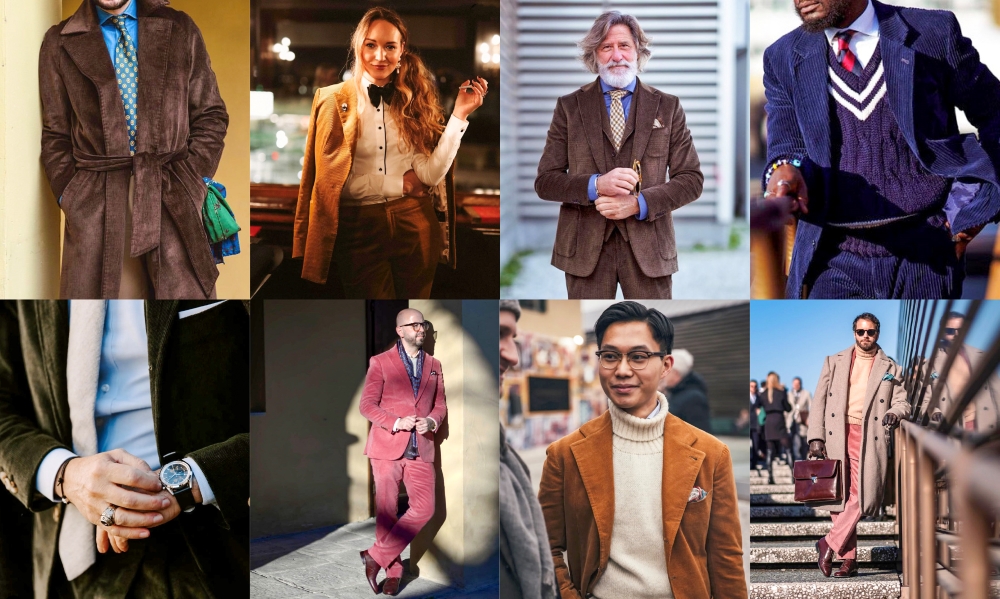JOURNAL
Pitti Uomo 103
The re-emergence of corduroy
The re-emergence of corduroy
Words & photography: Lee Osborne @sartorialee

One of the takeaways from the recent 103rd edition of Pitti Uomo in Florence was the re-emergence of corduroy in men’s
tailoring. No longer the reserve of Geography teachers, it has popped up now and again in previous seasons, but this
time around it was the defining fabric of the show. Everywhere you looked around the Fortezza da Basso and dispersing
into the surrounding hallowed streets of Florence, stylish attendees of the show were sporting various iterations of
the cloth, crafted into stylish 2-piece suits, jackets, utility wear, topcoats and even caps for both sexes.
Corduroy’s earliest ancestor was a cotton weave known as “fustian”, named after Fustat, the first capital of Egypt
under Muslim rule, what is now the historical centre of modern Cairo, where it was first developed in 200 BC and
remained a popular cloth for centuries. Corduroy’s popularity soared in mediaeval times when Italian merchants
introduced the fabric to Western European nobility. In pre-central heating times, the aristocracy clamoured for the
fabric’s insulatory properties, with Henry VIII reportedly a big fan.

Types of Corduroy
Standard corduroy
While standard corduroy fabric has 11 wales per inch, usually a corduroy fabric having anywhere between 8 and 13 wales per inch, is considered to be standard corduroy.Pinwale corduroy
Pinwale corduroy features a large number of tiny ridges within every square inch. The finest forms of pinwale corduroy can feature up to 21 wales per inch.Elephant cord
This type of corduroy, often referred to as Jumbo cord, has very large, thick cords, reminiscent of the distinctive folds on an elephant’s skin, with a wale number ranging anywhere between 1.5 and 6.Corduroy is comprised of a series of evenly-spaced vertical rows of soft pile, arranged in a distinct pattern referred to as a “cord” or a “wale.” Different types of corduroys are classified by the number of lengthwise pile rows per inch each possess — feathercord has 20-25; pinwale 16-23; regular wale 14; wide wale 6-10 while broad wale has 3-5.
Traditionally the fabric is cut with the pile brushing in an upward direction, giving the fabric a better sheen. In
the late 1960s, to give the fabric a more contemporary feel, some designers were known to have reversed the direction
of the pile. It’s a personal choice as to whether you prefer the pile to run up or down.


Our corduroy options can be found within our Eskdale Trousers Collection bunch, and are
available in two weights: 15oz and 22/23oz 100% pure cotton.
If you want a fabric with a bit more give and flexibility, akin to stretch denim, then why not try the corduroy available in our Comfort Zone Cotton Stretch book. The stretch corduroy comes in 8 and 14 wale in the same weights as the Eskdale set.
Generally-speaking, corduroy is not a fluid, drapey fabric, so it is best employed on more fitted garments. For a more formal tailored look needlecord is preferable as it's less bulky and sits neatly on the torso, with traditional flap pockets on the jacket and side-adjusted trousers. Cuffs are optional but I find the trousers sit better without. A more louche, relaxed cord suit made with a chunkier cord would probably feature patch pockets on the jacket to reflect that and belt loops on the trousers. It's definitely worth commissioning a full suit as it can always be broken up and worn as separates.
If you want a fabric with a bit more give and flexibility, akin to stretch denim, then why not try the corduroy available in our Comfort Zone Cotton Stretch book. The stretch corduroy comes in 8 and 14 wale in the same weights as the Eskdale set.
Generally-speaking, corduroy is not a fluid, drapey fabric, so it is best employed on more fitted garments. For a more formal tailored look needlecord is preferable as it's less bulky and sits neatly on the torso, with traditional flap pockets on the jacket and side-adjusted trousers. Cuffs are optional but I find the trousers sit better without. A more louche, relaxed cord suit made with a chunkier cord would probably feature patch pockets on the jacket to reflect that and belt loops on the trousers. It's definitely worth commissioning a full suit as it can always be broken up and worn as separates.
